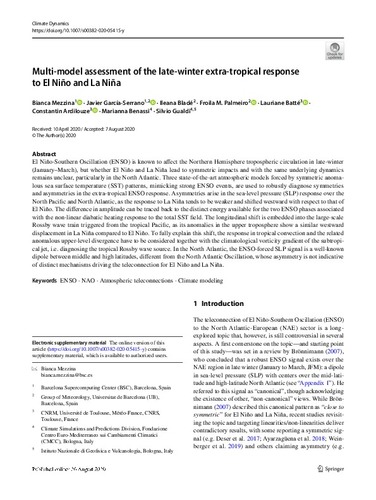Multi-model assessment of the late-winter extra-tropical response to El Niño and La Niña

Visualitza/Obre
Cita com:
hdl:2117/329442
Tipus de documentArticle
Data publicació2020-08
EditorSpringer
Condicions d'accésAccés obert
Llevat que s'hi indiqui el contrari, els
continguts d'aquesta obra estan subjectes a la llicència de Creative Commons
:
Reconeixement 3.0 Espanya
Abstract
El Niño-Southern Oscillation (ENSO) is known to affect the Northern Hemisphere tropospheric circulation in late-winter (January–March), but whether El Niño and La Niña lead to symmetric impacts and with the same underlying dynamics remains unclear, particularly in the North Atlantic. Three state-of-the-art atmospheric models forced by symmetric anomalous sea surface temperature (SST) patterns, mimicking strong ENSO events, are used to robustly diagnose symmetries and asymmetries in the extra-tropical ENSO response. Asymmetries arise in the sea-level pressure (SLP) response over the North Pacific and North Atlantic, as the response to La Niña tends to be weaker and shifted westward with respect to that of El Niño. The difference in amplitude can be traced back to the distinct energy available for the two ENSO phases associated with the non-linear diabatic heating response to the total SST field. The longitudinal shift is embedded into the large-scale Rossby wave train triggered from the tropical Pacific, as its anomalies in the upper troposphere show a similar westward displacement in La Niña compared to El Niño. To fully explain this shift, the response in tropical convection and the related anomalous upper-level divergence have to be considered together with the climatological vorticity gradient of the subtropical jet, i.e. diagnosing the tropical Rossby wave source. In the North Atlantic, the ENSO-forced SLP signal is a well-known dipole between middle and high latitudes, different from the North Atlantic Oscillation, whose asymmetry is not indicative of distinct mechanisms driving the teleconnection for El Niño and La Niña.
CitacióMezzina, B. [et al.]. Multi-model assessment of the late-winter extra-tropical response to El Niño and La Niña. "Climate Dynamics", Agost 2020,
ISSN0930-7575
Versió de l'editorhttps://link.springer.com/article/10.1007/s00382-020-05415-y
Col·leccions
| Fitxers | Descripció | Mida | Format | Visualitza |
|---|---|---|---|---|
| Mezzina2020_Art ... delAssessmentOfTheLate.pdf | 4,949Mb | Visualitza/Obre |


